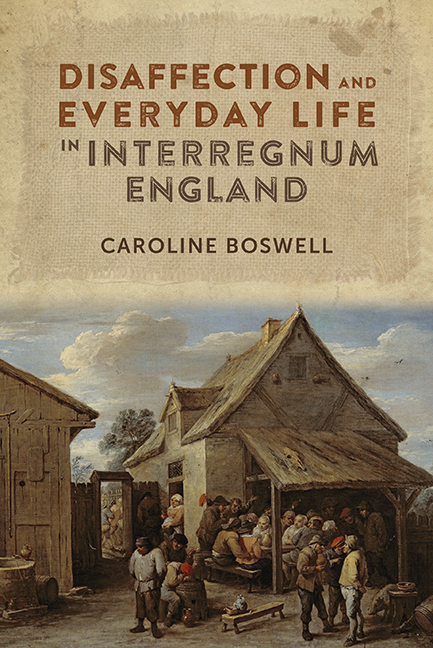Book contents
- Frontmatter
- Dedication
- Contents
- List of Illustrations
- Acknowledgements
- List of Abbreviations
- Introduction
- Part I Sites of Disaffection
- Part II Objects of Disaffection
- 3 Meddling Soldiers
- 4 The “Unnatural” Excise-man
- 5 The Rise of the “Fanatic”
- Conclusion
- Bibliography
- Index
- STUDIES IN EARLY MODERN CULTURAL, POLITICAL AND SOCIAL HISTORY
5 - The Rise of the “Fanatic”
from Part II - Objects of Disaffection
Published online by Cambridge University Press: 23 August 2019
- Frontmatter
- Dedication
- Contents
- List of Illustrations
- Acknowledgements
- List of Abbreviations
- Introduction
- Part I Sites of Disaffection
- Part II Objects of Disaffection
- 3 Meddling Soldiers
- 4 The “Unnatural” Excise-man
- 5 The Rise of the “Fanatic”
- Conclusion
- Bibliography
- Index
- STUDIES IN EARLY MODERN CULTURAL, POLITICAL AND SOCIAL HISTORY
Summary
Shortly before Charles II's triumphant return in 1660, a broadside appeared dissecting the “Character of a Phanatique”. The term “Phanatique”, its author asserted, referenced all those who railed against “Church and State”, but particularly “religious or irreligious mad men-Hereticks”. The writer described the fanatic as “a false Conception gotten by the Air upon the sick womb of a confused phancy”, and claimed that the indistinct creature “devours greedily all doctrines, but receives nourishment from none”. Suggesting that the fanatic subverted natural order, the author noted that one “may better express him in the Negative than the Affirmative”. As this vague description suggests, a fanatic's exact beliefs were elusive; the author remarked that “you may sooner pick all religions out of him than one”, especially as his doctrines daily “metamorphosed”. Opposing “true Religion” as well as “the publick good”, this creature threatened the order of things, both “Civil and Ecclesiastical”. Over the course of the revolution, the fanatic – though nebulous – represented the destruction of church and state through excessive zeal.
The author's verbose description of the “Phanatique” portrayed the dangers of these individuals with rhetorical flair, but it left the reader with a muddled understanding of what precisely defined this menace. In inventing the “fanatic” as the ultimate example of both religious and political subversion, royalist authors created a character whose faults and transgressions represented a broad range of anxieties surrounding the growth in extremism throughout the 1650s. People's anxiety over the spread of radicalism and the breakdown of the parish community, while directed at different groups of religious deviants at different moments within different communities, reflected a general concern that the continuance of broad definitions of toleration risked the moral, social and political order. Following the abolition of the Elizabeth Act of Uniformity, the Commonwealth and Protectorate failed to supply effective legislation that people could employ to rid their communities of unwelcome religious groups and individuals. The pervading sense was that the state's ineffective policies left the public with little or no recourse. Frustration prompted agitated crowds and individuals to assault religious “Others” who threatened their community's stability. Royalist propagandists channeled this general hostility toward the many forms of religious unorthodoxy and the state's apparent inaction when they fashioned the “fanatic” – a creature borne out of the English Revolution and nurtured by the interregnum regimes.
- Type
- Chapter
- Information
- Disaffection and Everyday Life in Interregnum England , pp. 205 - 236Publisher: Boydell & BrewerPrint publication year: 2017

